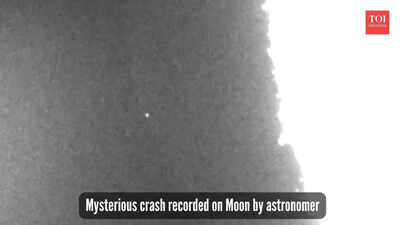ARTICLE AD BOX

Mysterious crash recorded on Moon by astronomer (Photo: @dfuji1/X)
Mystery and fascination have always been a part of celestial happenings, and as November 2025 brings in a treat for stargazers and astronomy enthusiasts, a bizarre ‘explosion’ apparently took place on the Moon, and it was captured by amateur astronomer Daichi Fujii, who is the curator at the Hiratsuka City Museum.Moon exploration missions are entering a new phase with ambitious plans to send humans for extended missions and build lunar bases. Yet, a constant threat remains in the form of meteor impacts. An example of this was seen on October 30 and November 1, 2025, when a large meteorite struck the Moon, creating a spectacular explosion visible from Earth.
Astronomer captures a meteorite struck on Moon
Amateur astronomer Daichi Fujii captured a rare and breathtaking flash on the Moon’s night side, recorded at an incredible 270 frames per second.
The footage was shared on his X account, and it shows a sudden burst of light marking the exact moment a small crater formed east of the well-known Gassendi Crater.Fujii’s meticulous observation revealed the meteoroid hit at 20:33:13.4 according to the Japan Standard Time and produced an intense flash lasting just 0.1 seconds, reaching a brightness of 8th magnitude.For the second impact that took place on the 1st of November, he wrote in his X post, “A lunar impact flash appeared last night as well! This is the flash at 20:49:19.4 on November 1, 2025 (270fps, 0.03x speed playback).”
Meteors don’t burn up on the way to the Moon’s surface
Unlike Earth, the Moon lacks an atmosphere, so meteoroids do not burn up as shooting stars. They collide directly with the surface, producing instant flashes of light and new craters. Scientists estimate that the impacting space rock weighed roughly 0.2 kilograms and created a crater approximately three meters wide.Based on the timing and location, experts link the meteoroid to the Taurid meteor showers, either Southern or Northern, that are both active during this period.
For the unversed, the Taurid meteoroids enter at around 27 kilometers per second and strike at an angle near 35 degrees.
Moon’s surface is constantly changing and is still influenced by meteors
This event reminds us about the ongoing bombardment that continues to influence the lunar surface. It also serves as an important reminder of the risks meteoroid impacts pose to spacecraft and future astronauts on the Moon.Photos from NASA’s Lunar Reconnaissance Orbiter (LRO) might provide detailed images, showing the newly formed crater and its surroundings, helping researchers better understand these impact phenomena.
Such data are crucial for planning safe future missions, giving scientists a better picture of the threats from space debris.The October 30 impact, followed by another on November 1 captured by Fujii, demonstrates the dynamic and sometimes dangerous environment of space near Earth. These stunning flashes are not only scientific treasures but also interesting moments that connect all of us to the vast universe beyond our planet.

 1 hour ago
5
1 hour ago
5








 English (US) ·
English (US) ·